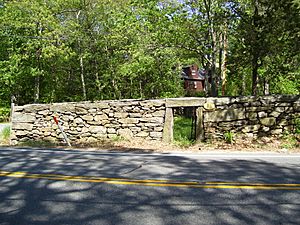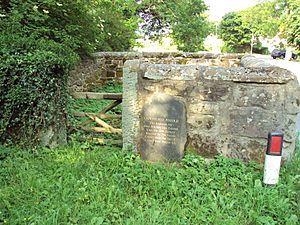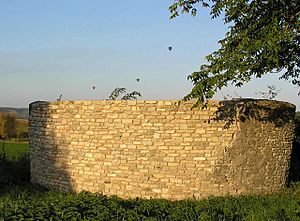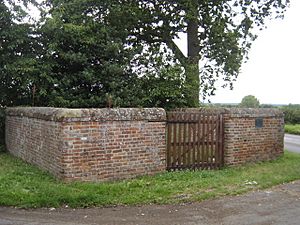Animal pound facts for kids
An animal pound was a special fenced area where stray farm animals were kept. These animals stayed in the pound until their owners came to claim them. If an owner wanted their animal back, they usually had to pay a fee. This fee helped cover the costs of keeping the animal safe in the pound. Sometimes, if an animal was not claimed, it might be sold.
Contents
What is a Pinfold or Pound?
The words "pinfold" and "pound" come from old Saxon languages. Both Pundfald and pund mean an enclosed area or a fence. There is no real difference between a pinfold and a village pound; they are the same thing.
The person who looked after the animals in the pinfold was called the "pinder." This old job title is where the family name Pinder comes from today.
Village Pounds in History



The village pound was a common sight in most English villages during the medieval period. You could also find them in the early English settlements in North America and in Ireland.
Purpose of a Village Pound
These structures had high walls and could be locked. Their main job was to hold stray sheep, pigs, and cattle. Animals ended up in the pound if they wandered off or caused damage to someone's land. Owners would pay a fine or fee to get their animals back.
How Pounds Looked
Pounds came in different sizes and shapes. Some were small, about 21 square meters (225 square feet). Others were much larger, up to half an acre. They could be square, rectangular, or even circular. The earliest pounds might have just been hedges, but most were built with strong stone or brick. This made them very secure for holding animals.
When Pounds Were Used
Village pounds have been around since the medieval times. By the 1500s, most villages and towns likely had their own pound. Most of the pounds we can still see today were built in the 1500s and 1600s. Some of these old pounds are now protected historical buildings. However, many have fallen apart over time.
How Stray Animals Were Managed
In 1930, the Sussex County Magazine described how pounds worked:
- Almost every village had a pound for stray animals like cattle, pigs, or geese.
- Animals found wandering were taken to the pound.
- Their owner had to pay a fine for any damage the animals caused.
- They also paid a fee to the pound keeper (a person, sometimes a woman) for feeding and watering the animals.
- If animals were not claimed within three weeks, they were taken to the nearest market and sold. The money went to the person who found the animals and the pound keeper.
The Tally-Stick System
Sometimes, a clever way to keep track of payments was used.
- The person who found the stray animals would cut a stick.
- They made a notch (a small cut) on the stick for each animal.
- Then, they split the stick down the middle of the notches. This meant half of each notch was on one piece, and the other half was on the other piece.
- The person who found the animals kept one half of the stick.
- They gave the other half to the pound keeper.
- When the owner came to get their animals, they paid the fine.
- The person who found the animals gave the owner their half of the stick.
- The owner then took this stick piece to the pound keeper.
- If the two pieces of the stick fit together perfectly, it proved the owner had paid. Then, their animals were set free.
- This is where the term "tally-stick" comes from. The pound keeper was sometimes called a "tallyman" because of this system.
Pounds Beyond England
While pounds were very common in England, they also existed in other places. For example, in the 1700s, nearly every town in New England (part of the United States) had a town pound. In some mountain areas of northern Spain, similar enclosures are still used today. They help protect beehives from bear attacks.

See Also
- Kraal
- Pen (enclosure)
- Scarisbrick, Lancashire, in which is the hamlet of Pinfold
- List of extant pinfolds in Cheshire
- Village lock-up
- Poundmaster


